The NVIDIA GeForce GTX 750 Ti and GTX 750 Review: Maxwell Makes Its Move
by Ryan Smith & Ganesh T S on February 18, 2014 9:00 AM ESTOverclocking: When Headroom Exceeds Clockspeed Limits
Last but not least we have our customary look at overclocking performance. With all 3 of our cards being based on the same reference design, we expect to see some relatively consistent results between the cards. At the same time NVIDIA has told us that GTX 750 has some very interesting overclocking properties, and boy they weren’t kidding.
On a quick note, as a GPU Boost 2.0 product, overclocking on the GTX 750 series is not any different than on other GTX 700 series cards. It’s still based on offset overclocking, with the user adjusting offsets for the final overclock. But with that said there are two things to point out. The first is that the power target is limited to 100% on all cards. Because these are sub-75W cards, NVIDIA is not allowing anyone to exceed the card’s default TDP, so you only have as much power to play with as you started with. Second of all, none of our cards had available overvoltage bins. Apparently some cards do, but ours did not, so our voltage bins maxed out at the default bins you see listed.
Finally, all 3 cards have a maximum clock offset of 135MHz. This will be an important fact in a little bit.
| GeForce GTX 750 Series Overclocking | |||||
| GTX 750 Ti (Ref) | Zotac GTX 750 Ti | Zotac GTX 750 | |||
| Shipping Core Clock | 1020MHz | 1033MHz | 1033MHz | ||
| Shipping Max Boost Clock | 1150MHz | 1175MHz | 1163MHz | ||
| Shipping Memory Clock | 5.4GHz | 5.4GHz | 5.0GHz | ||
| Shipping Max Boost Voltage | 1.168v | 1.137v | 1.187v | ||
| Overclock Core Clock | 1155MHz | 1168MHz | 1168MHz | ||
| Overclock Max Boost Clock | 1285MHz | 1310MHz | 1298MHz | ||
| Overclock Memory Clock | 6.3GHz | 6.1GHz | 6.0GHz | ||
| Overclock Max Boost Voltage | 1.168v | 1.137v | 1.187v | ||
As we can quickly see, two patterns emerge. The first is that with every card equipped with 6GHz memory (though we remain unsure which mode the Zotac GTX 750’s is in), each and every card hits at least 6GHz, and sometimes a bit more. With the 128-bit memory bus generally providing the biggest bottleneck for GM107, the fact that there is 12%+ overclocking headroom here is going to be very helpful in feeding the tiny beast that is GM107.
More significantly however is the core overclock. We maxed out every single one. Every card, from the NVIDIA reference card to the Zotac cards, had no trouble overclocking by the full 135MHz to their respective maximum overclocks. The Zotac GTX 750 Ti, having the highest maximum boost clock by default, is technically the winner here at 1310MHz. But at this point everyone is a winner. Going by the maximum boost clock, every card is capable of an 11% core overclock, to go with that tasty 12% memory overclock.
The fact of the matter is that this is not something we normally encounter. Sub-75W cards are not poor overclockers, but they’re not usually strong overclockers either, which is why a 135MHz offset limit makes sense at first glance. But it’s clear that NVIDIA underestimated their own overclocking potential here when setting the specifications for these cards, as there’s seeming some headroom left untapped. Without additional offset room it’s impossible to say just how much more overclocking headroom remains – it may not be very much – but there should be room for at least some additional overclocking.
At this point with cards already in the pipeline we’ll have to take a look at individual cards and see what manufacturers have set their offset limits at. If they have followed NVIDIA’s specifications, then they’ll be equally limited. But hopefully with the launch now behind them, NVIDIA’s partners can work with NVIDIA on making greater offsets available on newer batches of cards.
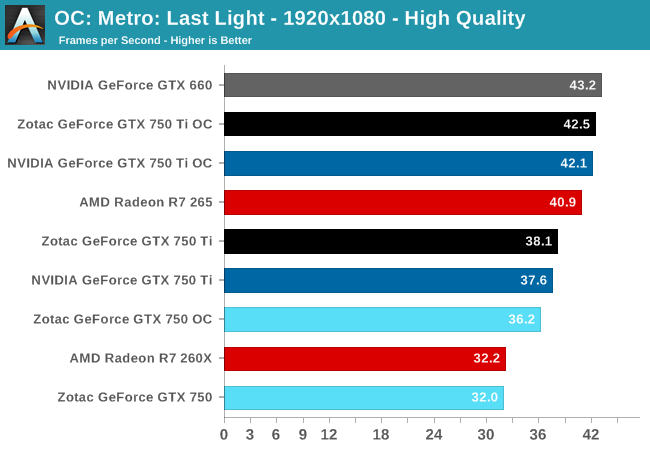
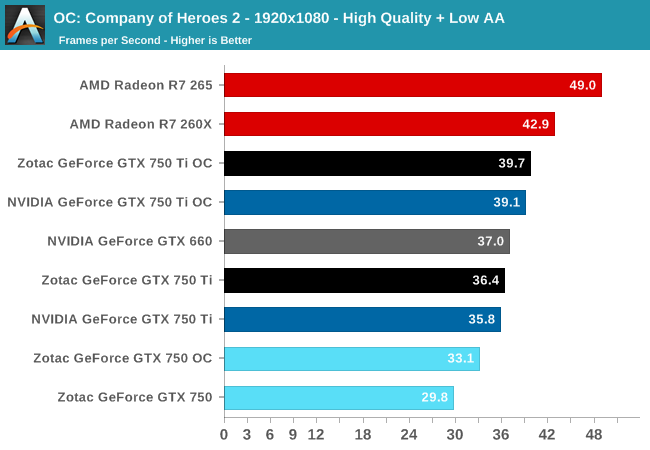
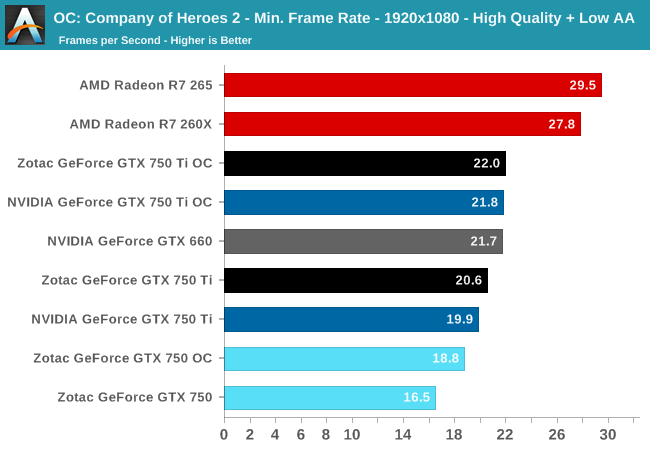

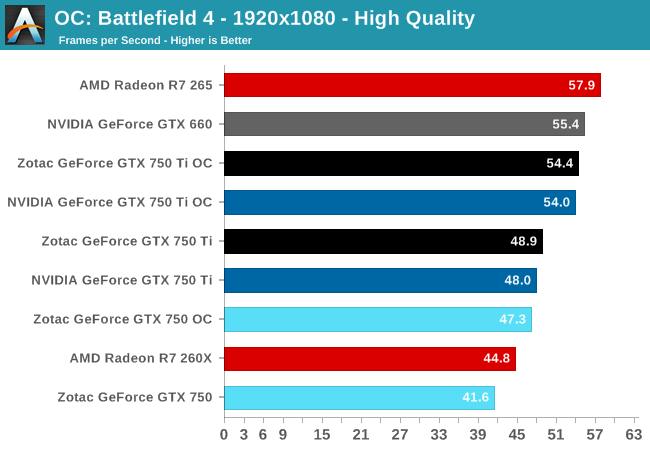
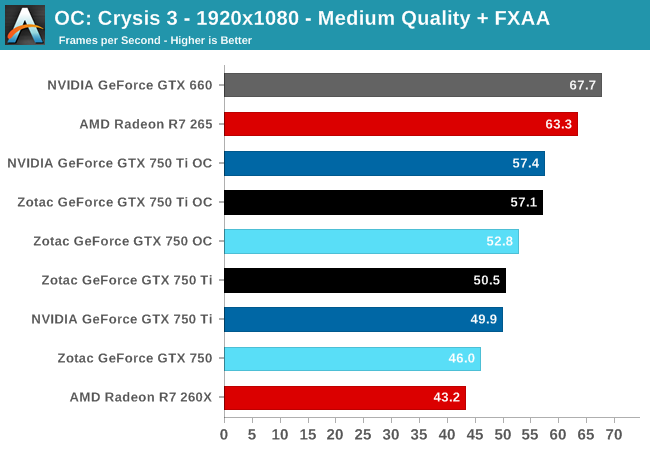
Depending on the game being used, the benefits from overclocking range from 9% to 12%, roughly in-line with our overclocks. For the GTX 750 this is sometimes enough to catch the stock clocked R7 260X, but even with this overclock the GTX 750 Ti will still generally trail the R7 265.
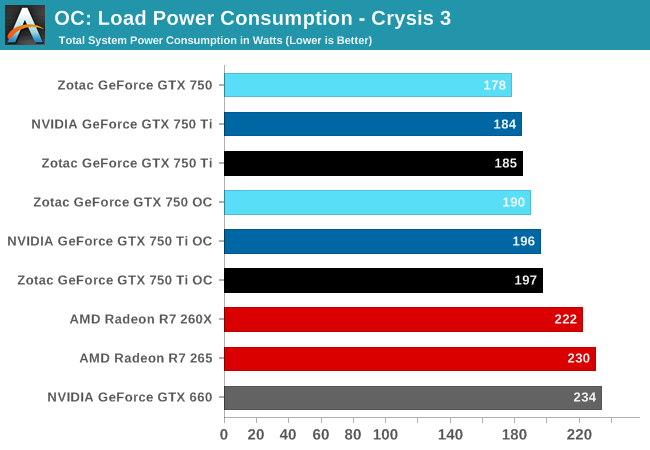

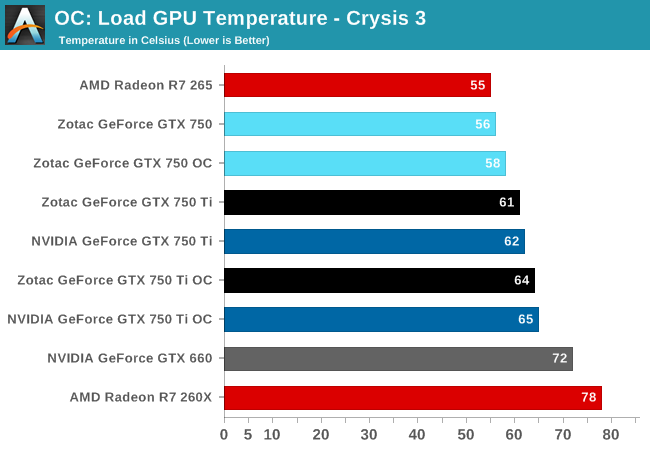
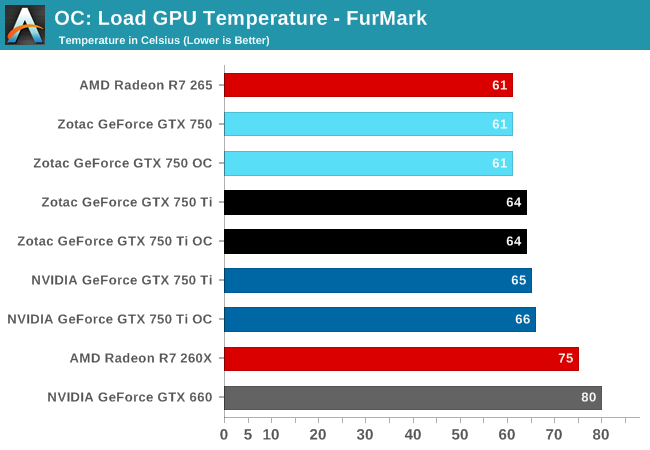
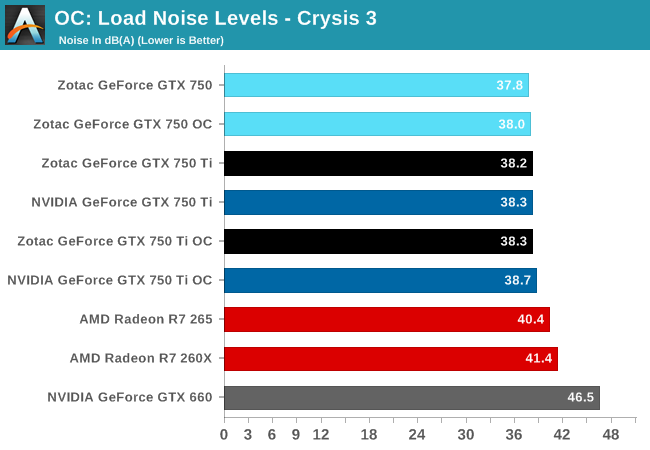
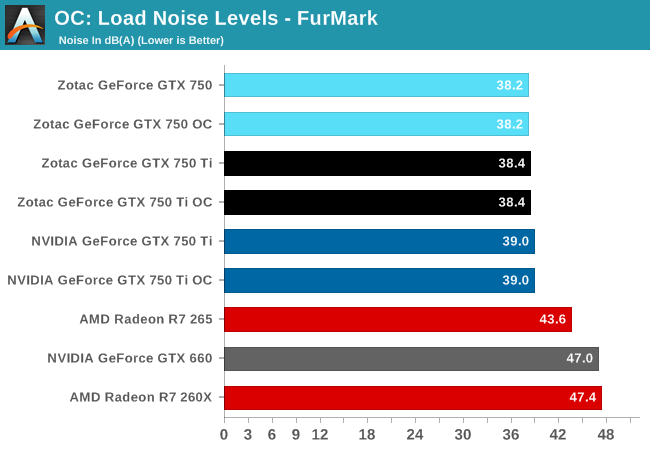
On the other hand, because of the hard TDP limit of 100%, this extra performance is relatively cheap. Video card power consumption moves by only a few watts, and then a few watts of CPU time on top of that. For all practical purposes overclocking can extend NVIDIA’s already incredible performance-per-watt ratio by another 10% with no meaningful impact on noise. Given the consistency of overclocking headroom we’ve seen in our GTX 750 series samples, this is one of those scenarios where overclocking is going to be a reasonable and (relatively) fool proof action to take.










177 Comments
View All Comments
Mondozai - Wednesday, February 19, 2014 - link
USA in recession? You are either ignorant or use your own home-cooked economics for "special" people like yourself.As for consoles. Sure you can get low-end cards for cheaper sums a PC but people buy consoles for their games, simplicity and the fact that they are increasingly multimedia machines for a low cost.
These factors will not change with these new cards.
Yojimbo - Wednesday, February 19, 2014 - link
I thought I remember reading a headline a while back that said Sony or Microsoft or both were not planning on selling their hardware for a loss this time...madmilk - Tuesday, February 18, 2014 - link
The launch PS3 cost over $800 to manufacture, and Sony lost something like $3 billion in the first two years from hardware sales even though the PS3 wasn't even selling that well. To a lesser extent, Microsoft had the same problem with the Xbox 360. Of course Sony and Microsoft would go for cheaper, mid-range off-the-shelf components this time around. No one wants to make the same mistake twice.Antronman - Tuesday, February 18, 2014 - link
Wow. What do they think, everybody here is an OC pro who has/had world records and has a monster closed loop browsing/gaming/work setup? I don't give a damn about lower power consumption if it means I have to OC the balls off the card!moozoo - Tuesday, February 18, 2014 - link
Please include at least one fp64 benchmark in the compute section.It is great that you found out and reported the fp64 ratio.
Its a pity there isn't at least one low power low profile card with good DP Gflops (at least enough to beat the CPU and form a compelling argument to switch API's)
At work we only get small form factor PCs, and asking for anything that looks different ends in politics.
Ryan Smith - Thursday, February 20, 2014 - link
For the moment FP64 data is available via Bench. This being a mainstream consumer card, it's purposely not built for high FP64 performance; FP64 is there for compatibility purposes rather than being able to do much in the way of useful work.This is a purposeful market segmentation move that won't be going anywhere. So cards such as the 750 Ti will always be very slow at FP64.
jrs77 - Tuesday, February 18, 2014 - link
Now we need a manufacturer to release a GTX750 with single-slot cooler.koolanceGamer - Tuesday, February 18, 2014 - link
While all of this "low power" stuff is a little boring to me (not that anything is really pushing the high end card) I hope that in the not too distant future even the video cards like the 780/Titan will be able to be powered by the PCI alone.I would love to do a gaming build with a PCI based SSD and no cables coming off the video cards, it would be so clean!
EdgeOfDetroit - Tuesday, February 18, 2014 - link
Well I want laser light circuit cables. So much faster than copper and they would look so clean, you wouldn't even know there was a cable there unless you put your hand into the laser beams to see the pretty lights...... Ahh crap another BSOD, these laser cables suck!
Devo2007 - Wednesday, February 19, 2014 - link
Starting to wonder what a good card to replace a GTX 560 Ti would be (that's still relatively affordable). Would I have to step up to something like the R9 270 or GTX 760 cards to make things worthwhile? The power savings of the GTX 750 Ti aren't really a big factor as I'm currently using a 650w PSU, but I also don't want to spend a ton of money.